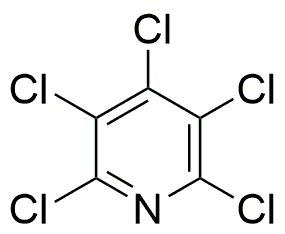Pentachloropyridine is widely utilized in research focused on:
- Agricultural Chemistry: It serves as a herbicide and pesticide, effectively controlling weeds and pests in various crops, thus enhancing agricultural productivity.
- Material Science: This compound is used in the synthesis of advanced materials, particularly in the development of polymers and coatings that require high thermal stability and resistance to degradation.
- Environmental Science: Researchers employ it in studies assessing the environmental impact of chlorinated compounds, aiding in the development of safer alternatives and remediation strategies.
- Pharmaceutical Research: Pentachloropyridine is explored for its potential in developing new pharmaceuticals, particularly in creating compounds with specific biological activities.
- Analytical Chemistry: It is utilized as a reagent in various analytical techniques, helping in the detection and quantification of other chemical substances in complex mixtures.
General Information
Properties
Safety and Regulations
Applications
Pentachloropyridine is widely utilized in research focused on:
- Agricultural Chemistry: It serves as a herbicide and pesticide, effectively controlling weeds and pests in various crops, thus enhancing agricultural productivity.
- Material Science: This compound is used in the synthesis of advanced materials, particularly in the development of polymers and coatings that require high thermal stability and resistance to degradation.
- Environmental Science: Researchers employ it in studies assessing the environmental impact of chlorinated compounds, aiding in the development of safer alternatives and remediation strategies.
- Pharmaceutical Research: Pentachloropyridine is explored for its potential in developing new pharmaceuticals, particularly in creating compounds with specific biological activities.
- Analytical Chemistry: It is utilized as a reagent in various analytical techniques, helping in the detection and quantification of other chemical substances in complex mixtures.
Documents
Safety Data Sheets (SDS)
The SDS provides comprehensive safety information on handling, storage, and disposal of the product.
Product Specification (PS)
The PS provides a comprehensive breakdown of the product’s properties, including chemical composition, physical state, purity, and storage requirements. It also details acceptable quality ranges and the product's intended applications.
Certificates of Analysis (COA)
Search for Certificates of Analysis (COA) by entering the products Lot Number. Lot and Batch Numbers can be found on a product’s label following the words ‘Lot’ or ‘Batch’.
*Catalog Number
*Lot Number
Certificates Of Origin (COO)
This COO confirms the country where the product was manufactured, and also details the materials and components used in it and whether it is derived from natural, synthetic, or other specific sources. This certificate may be required for customs, trade, and regulatory compliance.
*Catalog Number
*Lot Number
Safety Data Sheets (SDS)
The SDS provides comprehensive safety information on handling, storage, and disposal of the product.
DownloadProduct Specification (PS)
The PS provides a comprehensive breakdown of the product’s properties, including chemical composition, physical state, purity, and storage requirements. It also details acceptable quality ranges and the product's intended applications.
DownloadCertificates of Analysis (COA)
Search for Certificates of Analysis (COA) by entering the products Lot Number. Lot and Batch Numbers can be found on a product’s label following the words ‘Lot’ or ‘Batch’.
*Catalog Number
*Lot Number
Certificates Of Origin (COO)
This COO confirms the country where the product was manufactured, and also details the materials and components used in it and whether it is derived from natural, synthetic, or other specific sources. This certificate may be required for customs, trade, and regulatory compliance.


